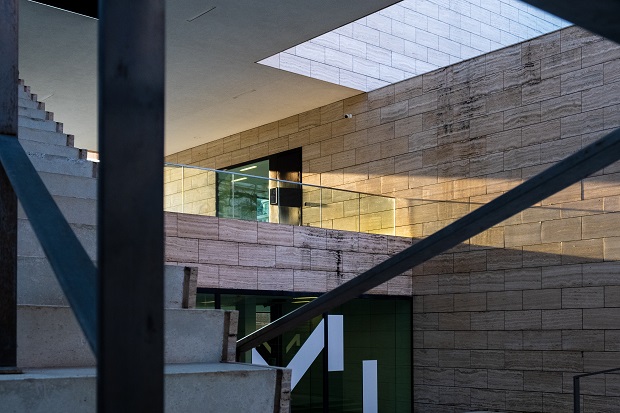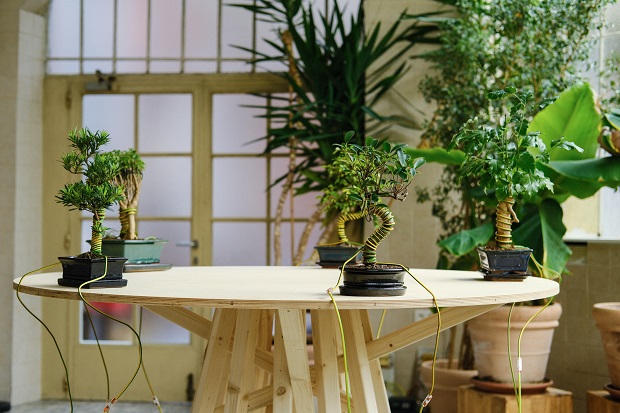- Daily & Weekly newsletters
- Buy & download The Bulletin
- Comment on our articles
Hear Here: Leuven’s walking tour of sound art is a timely lesson in listening
Strung up above the courtyard of Leuven arts centre Stuk, a cobweb of 180 ceremonial bells and instruments await a human trigger to begin their gentle yet mesmerising sound.
Handclapping, footsteps and voices can all set off the AI-driven and site specific work Dhvāni (pictured above) by Indian artist Budhaditya Chattopadhyay. The title means resonance in Sanskrit; the installation drawing attention to the social aspect of the courtyard site while delivering a lesson in patience and mindfulness.
This is the first sound art installation of Hear Here, a free promenade tour around nine different historic locations in the city centre that is running until 9 June. Presented as a walk in the city combining heritage, tourism and culture, it is designed to be highly accessible for all ages with guided tours also an option.
Surprised by the success of a first edition in 2022 that attracted over 25,000 visitors, Stuk decided to turn the tour into a triennial event for the lively dance, image and sound centre. This second edition honours the 600th anniversary of KU Leuven, Belgium’s oldest university.

All the installations are sited in its buildings for a facinating dialogue, explains curator Gilles Helsen. “From colleges to a 12th-century water gate, the Museum M (pictured above), a baroque chapel and even the Stuk, which was once the university’s chemical lab, the locations show the variety of its architecture,” he says.
The cutting-edge artworks are by Belgian and international artists, both emerging and pioneering. If two of the installations feature almost imperceptible sound, they are all about listening, points out Helsen. “Sound art is all about helping people to pause and listen to the world around them,” he says.
Stuk is home to two other intriguing installations. In a darkened room, Anri Sala’s video of a snail creeping up the string bow of a viola as a musician plays a Stravinsky elegy is a fascinating watch. It is also a poignant reflection on the speed of our lives and an invitation by the Albanian artist to embrace stillness.

Two adjacent spaces have been set aside for A Large Inscription, A Great Noise, two works by Canadian Adam Basanta that enable visitors to experience for themselves the concept of time. In one, a microphone is painstakingly dragged through a circle of gravel, while in the second (pictured above), tension mounts among the audience as a heavy cement block is slowly raised until it is eventually dropped with a deafening bang.

The nearby Dijlepark – a beautifully secluded pond-filled green spot – is home to Swiss artist Rudy Decelière’s subtly thought-provoking work Shallow Water (pictured above). Housed in an 18th-century octagonal pavilion, a round circular surface is filled with hundreds of gently-vibrating dried beech leaves. They delicately rustle thanks to a sophisticated system of magnets and copper wires triggering short impulses. The faintest of sounds created requires attentive listening. Stepping out of the intimate space afterwards, the noises of nature from the surrounding park and water birds are instantly even more perceptible.
Down by the flowing Dijle River, the tiny ground-floor room of the newly-restored medieval Justus Lipsius water tower is the setting for Slovak artist Jonáš Gruska’s installation of bells and timepieces. Zvon employs cowbells from his homeland and significantly a clock made from melted bullet casings from the past world wars. In a city where bells are continually chiming, this ringing installation recalls the significance of tinkling or tolling bells, from their use by shepherds to acting as a warning of invading armies.

Another freshly-refurbished heritage site opening its doors for the art tour is the white-walled octagonal KADOC chapel. Young Belgian artist Anouk Kellner fills the space with her Airchoir No 2: Dirges for Codes Organ Voice (pictured above). A strange cacophony of sounds, strangely meditative, fill the once hallowed space. Kellner has dismantled a church organ – an instrument much appreciated by sound artists – and connected its pipes to various-sized inflatable textile bags. Her highly-original music composition consists of a symphony of breathwork sounds created by bellows, organ pipes and tubes.

Other highlights of the tour include a bonsai tree work by German sound art pioneer Christina Kubisch, in which the miniature plants ‘communicate’ via electromagnetic waves. The Conference of Trees (pictured above) can be found in the conservatory of Hollands College.
To explore all of the installations and sites, visitors can pick up a handy Hear Here map from the ground floor of the Stuk arts centre. The full tour takes around two-and-a-half hours, although it is also possible to follow your own itinerary. While most participants walk the trail, it is also possible to visit each location by bike.
Admission is free, but voluntary contributions are welcome. Instead of a donation box, the sound artwork Money Socks by Jelle Mastenbroek collects coins. Registration is required for themed guided tours, such as Apero and Meditatio’ in English, while a family tour in Dutch is suitable for kids aged six and up.
Hear Here
Until 9 June
Stuk
Naamsestraat 96
Leuven
Photos: (main image) Budhaditya Chattopadhyay - Dhvani ©Staf Smets; Museum M ©Staf Smets; Adam Basanta ©Paul Litherand; CRudy Decelière Shallow Water GAIS; Anouk Kellner - Airchoir No. 2- Dirges for Coded Organ Voices ©Staf Smets; Christina Kubisch — The Conference of the Trees ©Joeri Thiry

















